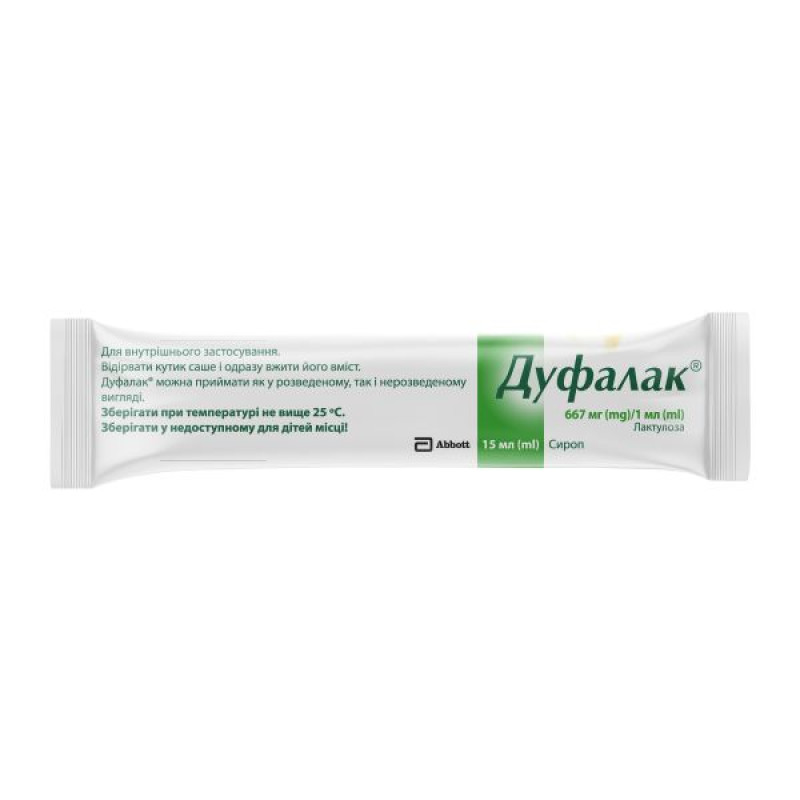Dufalak syrup 667 mg/ml sachet 15 ml #10

Instructions Duphalac syrup 667 mg/ml sachet 15 ml No. 10
Composition
active ingredient: lactulose;
1 ml of syrup contains 667 mg of lactulose;
excipient: purified water.
Dosage form
Syrup.
Main physicochemical properties: transparent thick liquid from colorless to brownish-yellow.
Pharmacotherapeutic group
Osmotic laxatives. ATX code A06A D11.
Pharmacological properties
Pharmacodynamics.
In the colon, lactulose is broken down by intestinal bacteria to low-molecular organic acids. These acids lower the pH in the lumen of the colon and, through the osmotic effect, increase the volume of intestinal contents. This stimulates colonic peristalsis and normalizes the consistency of stool. Constipation is corrected and the physiological rhythm of the intestine is restored.
In hepatic encephalopathy (or hepatic coma and precoma), the effect of the drug is due to the inhibition of the growth of proteolytic bacteria by increasing the number of acidophilic bacteria (for example, lactobacilli), binding of ammonia in ionic form due to acidification of the intestinal contents, cleansing of the large intestine due to low pH, as well as the osmotic effect, changing bacterial nitrogen metabolism by stimulating the utilization of ammonia by bacteria for the synthesis of bacterial proteins. In the context of the above, it is necessary, however, to note that the neuropsychiatric manifestations of hepatic encephalopathy cannot be explained only by hyperammonemia. However, ammonia can be considered as a model for other nitrogen compounds.
Lactulose, as a prebiotic, enhances the growth of beneficial bacteria such as bifidobacteria and lactobacteria, while potentially pathogenic bacteria such as clostridia and E. coli may be inhibited. This may lead to a more favorable balance of intestinal flora.
Pharmacokinetics.
Lactulose is almost not absorbed after oral administration and reaches the large intestine in an unchanged state, where it is metabolized by bacterial flora. When using Duphalac® in a dose of 25-50 g or 40-75 ml, lactulose is completely metabolized. When using higher doses, part of lactulose may be excreted in an unchanged state.
Indication
- Constipation: regulation of the physiological rhythm of the intestine.
- Conditions requiring relief of defecation (hemorrhoids, after operations on the colon and anorectal area).
- Hepatic encephalopathy: treatment and prevention of hepatic coma and precoma.
Contraindication
Hypersensitivity to the active substance or to any of the other ingredients of the drug, galactosemia, gastrointestinal obstruction, gastrointestinal perforation or risk of gastrointestinal perforation.
Interaction with other medicinal products and other types of interactions
Interaction studies have not been conducted.
Lactulose may increase potassium loss induced by other drugs (e.g. thiazide diuretics, corticosteroids and amphotericin B). Potassium deficiency may potentiate the effect of cardiac glycosides.
Application features
A doctor's consultation is recommended if:
– before starting treatment, there are painful symptoms in the abdominal area of unknown origin;
– the therapeutic effect within several days of treatment is insufficient.
Patients with lactose intolerance should use Duphalac® with caution.
The dose of the drug typically used to treat constipation does not usually cause problems in diabetic patients. However, the dose used to treat hepatic encephalopathy is usually much higher, so this should be taken into account when treating diabetic patients.
Long-term use of the drug without dose adjustment or improper use can lead to diarrhea and electrolyte imbalance.
This medicinal product contains lactose, galactose and small amounts of fructose. Therefore, patients with rare hereditary problems of galactose or fructose intolerance, the Lapp lactase deficiency or glucose-galactose malabsorption should not take this medicinal product.
This medicine contains sulphites as a result of the manufacturing process. Sulfites may rarely cause severe hypersensitivity reactions including bronchospasm.
Patients with gastrocardiac syndrome (Remheld's syndrome) should use lactulose only after consulting a doctor. In order to prevent the occurrence of flatulence, it is recommended to increase the dose gradually. If flatulence occurs, the dose should be reduced or treatment should be discontinued.
Use during pregnancy or breastfeeding
Pregnancy
No effects are expected during pregnancy, as the systemic effects of lactulose on the pregnant woman are negligible.
Duphalac® syrup can be used during pregnancy.
Breastfeeding period
During breastfeeding, no effects on the newborn/infant are expected, as the systemic exposure of lactulose to the breastfeeding woman is negligible.
Duphalac® syrup can be used during breastfeeding.
Fertility
No effects are expected, as the systemic exposure to lactulose is negligible.
Ability to influence reaction speed when driving vehicles or other mechanisms
Duphalac® has no or negligible influence on the ability to drive and use machines.
Method of administration and doses
Duphalac® can be taken both diluted and undiluted.
The dose should be adjusted according to the individual needs of the patient.
A single dose of lactulose should be swallowed immediately and should not be held in the mouth for a long time.
If the patient is prescribed the drug once a day, the dose should always be taken at the same time of day, for example, during breakfast. During laxative therapy, it is recommended to drink a sufficient amount of fluid (1.5-2 liters, which corresponds to 6-8 glasses) throughout the day.
When using the drug in vials, you can use a measuring cap.
When using the drug in single-dose sachets of 15 ml, it is necessary to tear off the corner of the sachet and immediately consume its contents.
Dosage for constipation or to soften stools for medical purposes
Lactulose can be taken as a single daily dose or divided into 2 doses; when using Duphalac® in bottles, you can use a measuring cap.
After a few days, the initial dose may be adjusted to a maintenance dose based on response to treatment. It may take several days of therapy (2-3 days) before a therapeutic effect is seen.
| Age | Initial dose, per day | Maintenance dose, per day |
| Adults and children aged 14 and over | 15-45 ml (= 1-3 sachets) | 15-30 ml (= 1-2 sachets) |
| Children aged 7-14 years | 15 ml (= 1 sachet) | 10-15 ml (= 1 sachet)* |
| Children aged 1-6 years* | 5-10 ml | 5-10 ml |
| Children under 1 year old* | up to 5 ml | up to 5 ml |
* If the maintenance dose is less than 15 ml, and for accurate dosing in infants and children under 7 years of age, Duphalac® should be used in vials.
Dosage for hepatic encephalopathy (adults only)
Initial dose: 30-45 ml (2-3 sachets) 3-4 times a day.
This dose may be adjusted to a maintenance dose to achieve soft bowel movements 2 to 3 times daily.
Children
The safety and efficacy of the drug in children (ages birth to 18 years) with hepatic encephalopathy have not been established. Data are not available.
Elderly patients and patients with renal or hepatic insufficiency
Since the systemic exposure to lactulose is negligible, there are no specific dosage recommendations for these patient groups.
Children.
The use of laxatives in children should be in exceptional cases and requires medical supervision.
It should be noted that the defecation reflex may be impaired during treatment.
Overdose
If the dose is too high, symptoms such as abdominal pain and diarrhea may occur. Recommended treatment includes stopping the drug or reducing the dose, and correcting electrolyte imbalances in case of excessive fluid loss due to diarrhea or vomiting.
Adverse reactions
Overall safety profile
During the first few days of treatment, flatulence may occur, which usually disappears after a few days. When using the drug in doses exceeding the recommended ones, abdominal pain and diarrhea may occur. In such cases, the dose should be reduced. When using high therapeutic doses for a long time (usually only in patients with hepatic encephalopathy), electrolyte imbalance may occur due to diarrhea.
During post-marketing use, hypersensitivity reactions, mainly limited to skin manifestations, have been observed and identified as possible adverse reactions. As these reactions were reported spontaneously from a patient population of uncertain size, it is not possible to reliably estimate their frequency.
List of adverse reactions
The following adverse reactions occurred with the indicated frequency in patients treated with lactulose in placebo-controlled clinical trials [very common (≥1/10), common (≥1/100 to <1/10), uncommon (≥1/1,000 to <1/100), rare (≥1/10,000 to <1/1,000), very rare (<1/10,000)], or were reported spontaneously during post-marketing use [frequency unknown (exact frequency cannot be estimated from the available data)].
On the part of the immune system: with an unknown frequency - hypersensitivity.
Gastrointestinal: very often - diarrhea; often - flatulence, abdominal pain, nausea and vomiting.
Skin and subcutaneous tissue disorders: frequency unknown - rash, itching, urticaria, erythema.
Laboratory abnormalities: uncommon – electrolyte imbalance due to diarrhea.
Children
The safety profile in children is expected to be the same as in adults.
Reporting adverse reactions after the registration of a medicinal product is important. This allows monitoring of the benefit/risk ratio when using this medicinal product. Medical and pharmaceutical professionals, as well as patients or their legal representatives, should report all cases of suspected adverse reactions and lack of efficacy of the medicinal product via the Automated Information System for Pharmacovigilance at the link: https://aisf.dec.gov.ua.
Also, in case of any adverse reactions or lack of effectiveness during the use of the drug or complaints about the quality of the drug, please contact Abbott Ukraine LLC by phone: +38 044-498-60-80 or e-mail: pv.ukraine@abbott.com.
Expiration date
3 years.
Storage conditions
Store at a temperature not exceeding 25 ° C. Keep out of the reach of children!
Packaging
200 ml or 300 ml, 500 ml or 1000 ml high density polyethylene bottles with polypropylene cap and measuring cap. Graduations on the measuring cap at 2.5 ml, 5 ml, 10 ml, 15 ml, 20 ml, 25 ml and 30 ml.
Sachets made of polyester-aluminum-polyester-polyethylene laminate, containing 15 ml of syrup, are packed in cardboard boxes of 10, 20 and 50 pieces.
Vacation category
Without a prescription.
Producer
Abbott Biologicals BV, The Netherlands.
Location of the manufacturer and address of its place of business. Veerweg 12, 8121 AA Olst, The Netherlands.
There are no reviews for this product.
There are no reviews for this product, be the first to leave your review.
No questions about this product, be the first and ask your question.


















